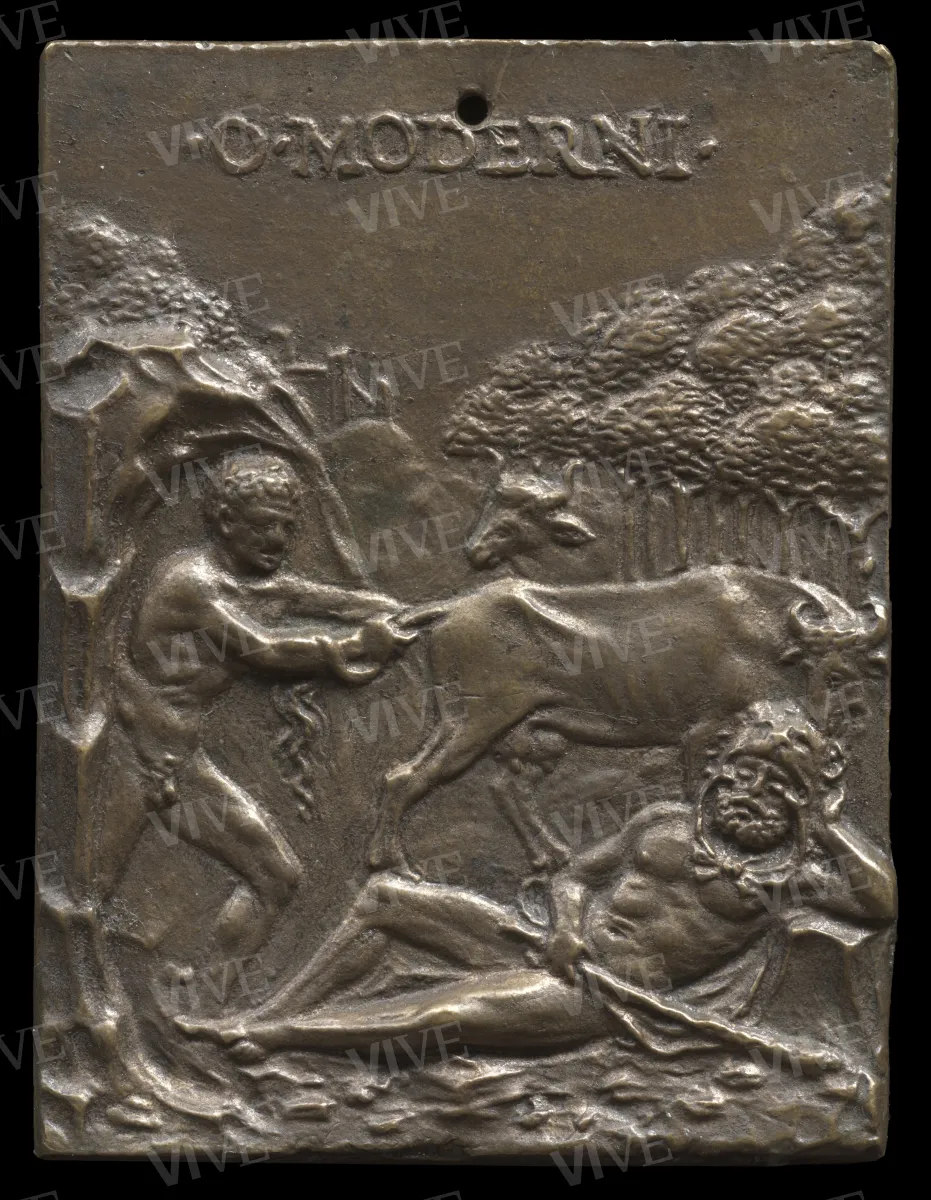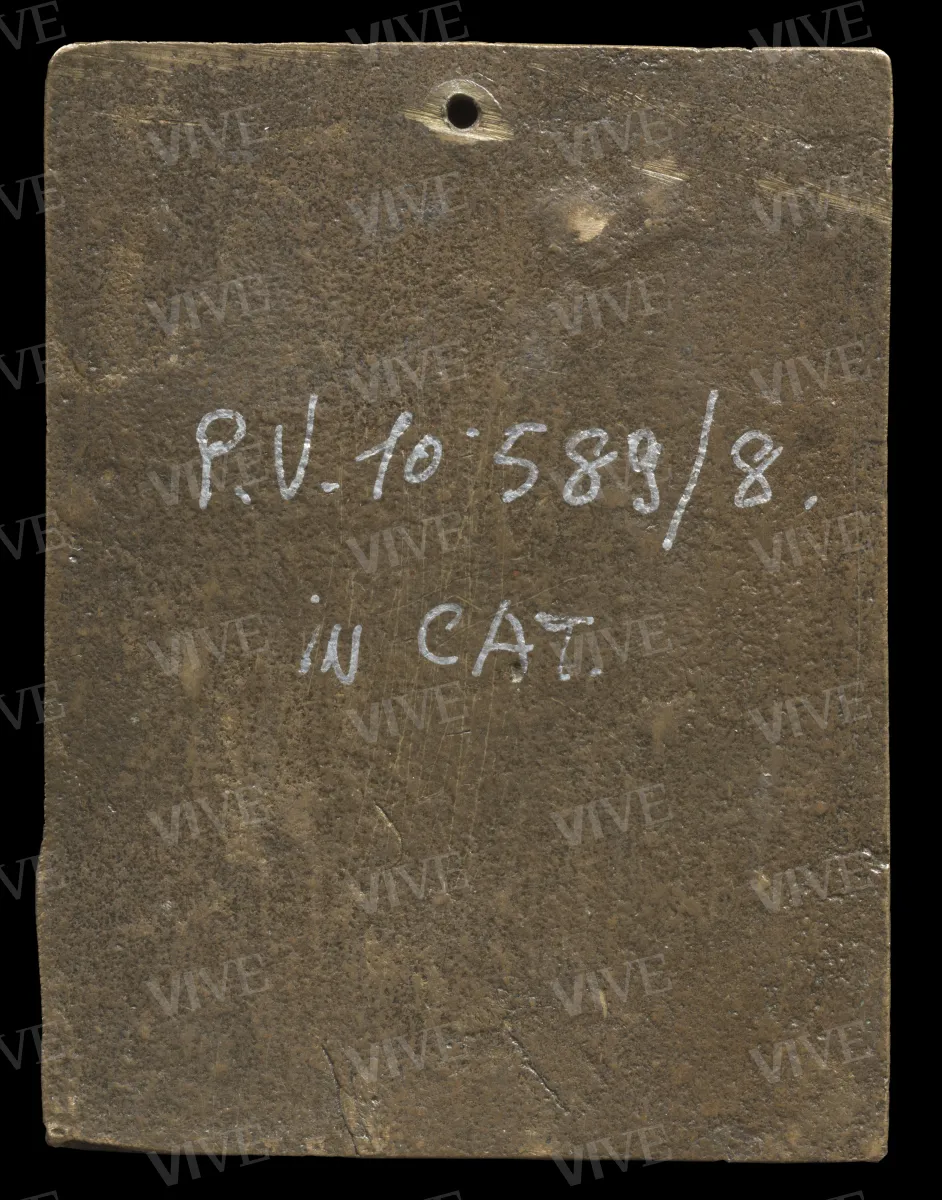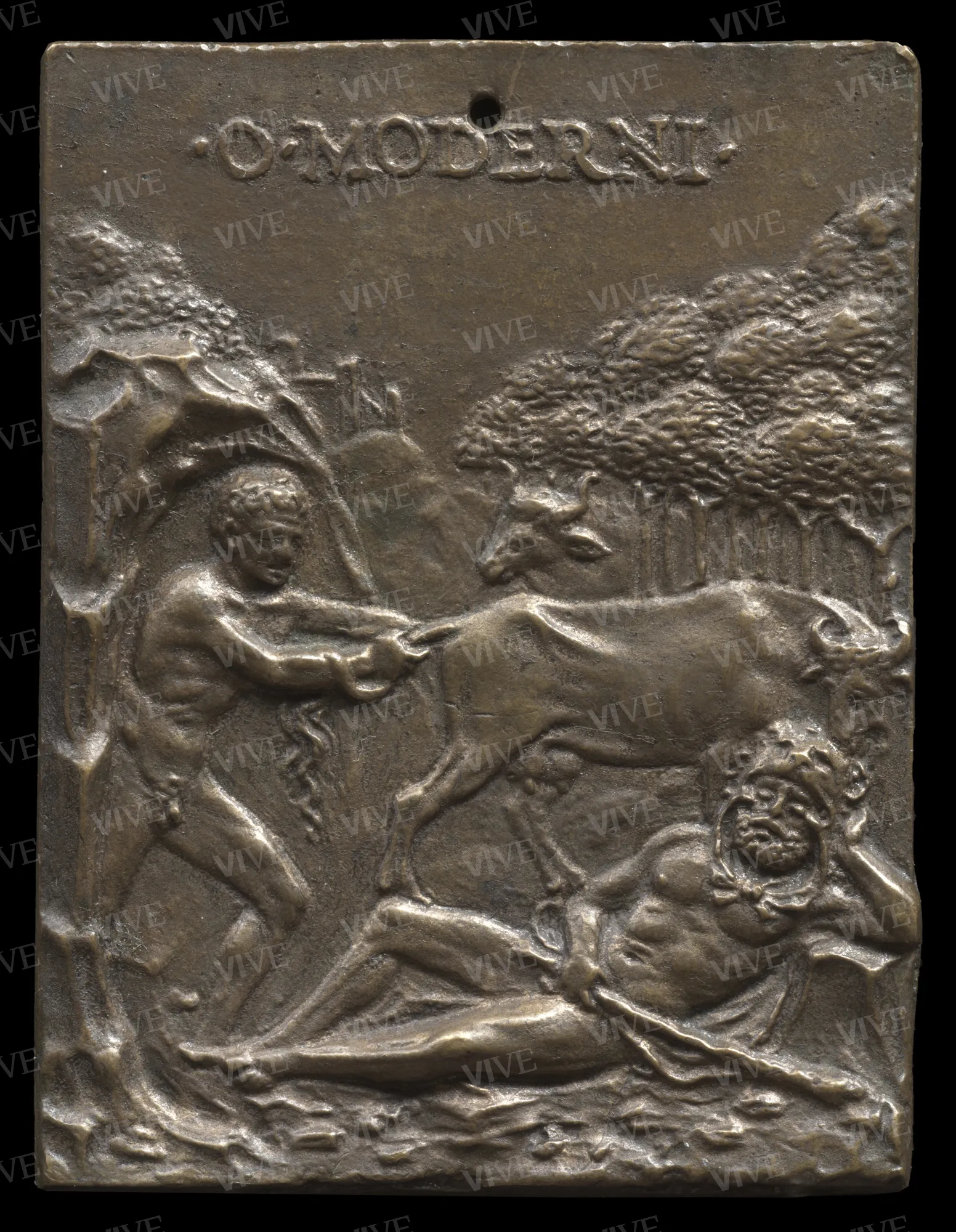Cacus steals the heifers from Hercules
Galeazzo Mondella called Il Moderno C. 1487-1490
The plaque, which shows Cacus stealing heifers from the sleeping Hercules, was created by Galeazzo Mondella, also known as Il Moderno, a goldsmith from Verona. It is dated to the late fifteenth century. The place where it was made is unknown, but the Mantegnaesque style of the relief suggests it could be from the Veneto region or the Este court (Ferrara, Mantua). The meticulously fashioned bronze plate demonstrates the artist's ability to produce detailed compositions in small-format works.
The plaque, which shows Cacus stealing heifers from the sleeping Hercules, was created by Galeazzo Mondella, also known as Il Moderno, a goldsmith from Verona. It is dated to the late fifteenth century. The place where it was made is unknown, but the Mantegnaesque style of the relief suggests it could be from the Veneto region or the Este court (Ferrara, Mantua). The meticulously fashioned bronze plate demonstrates the artist's ability to produce detailed compositions in small-format works.
Details of work
Catalog entry
The plaque depicts a sleeping Hercules lying on the ground, holding his club and wearing the skin of the Nemean lion he killed. In the left background, Cacus is shown dragging a heifer by its tail into his cave, with the head of a bull visible behind it. The scene is set against a wooded background on elevated terrain, with a walled city featuring towers. The inscription “· O · MODERNI ·” in the sky indicates that the work was created by Veronese goldsmith Galeazzo Mondella, known as Il Moderno (1467–1528), a prolific plaque maker during the Renaissance. This piece was acquired in 1958 for the Museo di Palazzo Venezia, along with more than one hundred medals and plaques from the collection of lawyer Domenico Ravajoli. The plaque belongs to a series of four illustrating stories of Hercules (Hercules and the Centaur, Hercules and the Oxen of Geryon, Hercules and Antaeus) inspired by Virgil’s Aeneid. The group can be dated to between the late fifteenth and early sixteenth centuries, specifically by 1507, as evidenced by the Frog Gate in Como which features depictions drawn from these small plaques with a Herculean theme. Lewis (1989) suggests an earlier date, around 1487, prior to the artist’s trip to Rome. This timeline aligns with the Mantegnaesque culture of the series (Rossi 2003), leading to the hypothesis that they were created in Padua (Rossi 1974, p. 33) or at the Este court. Historically, it has been speculated that the Herculean theme might refer to Ercole I d’Este, the possible commissioner of the series and father of Isabella d’Este (Hill 1917, p. 109; Rossi 2007).
The plaque exemplifies Mondella’s proficiency in creating scenes with varied depth, ranging from foreground characters to distant natural elements. Notably, the bronze reaches its greatest thickness at the knee of Hercules’ outstretched leg. The extensive use of Il Moderno’s plaques (Rossi 2012) has facilitated understanding of their composition in other artistic contexts. For instance, Galeazzo Rivelli's pictorial cycle from 1513, which adorns the study annexed to the church of Sant’Abbondio in Cremona, features two faux bronze tondos that replicate Il Moderno’s plaques depicting Cacus Stealing the Heifers of Hercules and Hercules and Antaeus (Bange 1922; Pope-Hennessy 1965; Bora 1997). Additionally, examples of the plaque have been integrated into sixteenth-century incense burners credited to Desiderio da Firenze and painted in Matthäus Schwarz’s prayer book from 1521 (Warren 2014, I, pp. 196–206 n. 50; III, pp. 764, fig. 278; pp. 854–855, nn. 308–310), illustrating their reuse in various settings and widespread distribution. Several examples of this plaque can be found in various museums and collections. Notable instances include those at the Bargello in Florence (inv. 166 B; Supino 1898; Panvini Rosati 1968; Toderi, Vannel Toderi 1996), the Museo di Capodimonte in Naples (from the Farnese collection; Filangieri di Candida 1899; Arbace 1996), Palazzo Madama in Turin (inv. 1177/B), and Berlin (Bange 1922, n. 482). Additionally, there are two plaques in Vienna (Planiscig 1924; Leithe-Jasper 1976). Some plaques are rectangular and unsigned, as referenced by Pope-Hennessy (1965), Wilson (1983), Jestaz (1997), and Washington's National Gallery of Art (inv. 1957.14.315). Circular examples can be found in Cleveland (Wixom 1975), Oxford (Warren 2014), and Ravenna (Martini 1985). Round versions with a palmette frame are present at Palazzo Madama in Turin (inv. 1094/B), the Musei Civici in Brescia (Rossi 1974, no. 44), and the Victoria & Albert Museum in London (Maclagan 1924; featuring two other distinct examples). The British Museum houses three different plaques (Pollard 1989) and a niello version depicting Hercules asleep, likely originating from the Bologna area (Hind 1936; Middeldorf, Goetz 1944). Rossi (1974), Jestaz (1997), Wixom (1975), and Martini (1985) have extensively documented these various examples.
Giulio Pietrobelli
Entry published on 27 March 2025
State of conservation
Good. Natural brown patina.
Inscriptions
“· O · MODERNI ·”
Provenance
Collection of Domenico Ravajoli, no. 8;
Rome, Museo Nazionale di Palazzo Venezia, purchased by the Italian State, 1958.
Exhibition history
Rome, Biblioteca Nazionale Centrale, Virgilio nell’arte e nella cultura europea, September 24–November 24, 1981.
References
Molinier Émile, Les bronzes italiens de la Renaissance. Les plaquettes. Catalogue raisonné, Paris 1886, I, p. 145, n. 194;
Supino Igino (a cura di), Catalogo del R. Museo Nazionale di Firenze (Palazzo del Podestà), Roma 1898, p. 108, n. 424;
Filangieri di Candida Antonio, Le placchette del Museo Nazionale di Napoli, in «Le Gallerie Nazionali Italiane. Notizie e documenti.», anno IV, Roma 1899, p. 223, n. 41;
Hill G. F., The Whitcombe Greene Plaquettes, in «The Burlington Magazine for Conoisseurs», 30, marzo 1917, 168, pp. 103-110;
Bange Ernst Friedrich (a cura di), Die Italienischen Brozen der Renaissance und des Barock: Riliefs und Plaketten, Berlin 1922, pp. 66-67, n. 482, tav. 47;
Planiscig Leo, Die bronzeplastiken statuette, reliefs, gerate und plaketten. Katalog, Wien 1924, pp. 248-250, n. 411;
Maclagan Eric, Victoria & Albert Museum. Catalogue of Italian Plaquettes, London 1924, pp. 37-38;
De Ricci Seymour, The Gustave Dreyfus Collection. Reliefs and Plaquettes, Oxford 1931, p. 144, n. 191;
Hind Arthur Mayger, Nielli, Chiefly Italian of the XV Century. Plates. Sulphur Casts and Prints preserved in the British Museum, London 1936, p. 28 n. 14, tav. VII;
Middeldorf Ulrich, Goetz Oswald, Medals and Plaquettes from the Sigmund Morgenroth Collection, Chicago 1944, p. 34, n. 240
Santangelo Antonino, Medaglie e placchette della coll. Ravajoli, in «Bollettino d’arte», XLIII, ottobre-dicembre 1958, pp. 376-377;
Pope-Hennessy John, Renaissance Bronzes from the Samuel Kress H. Collection, London 1965, p. 43, n. 135, fig. 154;
Panvini Rosati Franco, Medaglie e placchette italiane dal Rinascimento al XVIII secolo, Roma 1968, p. 71, n. 25;
Rossi Francesco (a cura di), Musei Civici di Brescia. Placchette secoli XV-XIX, Vicenza 1974, pp. 33-34, n. 43;
Wixom William, Renaissance Bronzes from Ohio Collections, The Cleveland Museum of Art, Cleveland 1975, n. 35;
Leithe-Jasper, in Italienische Kleinplastiken, Zeichnungen und Musik der Renaissance, Waffen des 16. und 17. Jahrunderts, catalogo della mostra (Schallaburg, Castello, 1 maggio-2 novembre 1976), s. l. 1976, p. 202, nn. 263-264;
Cannata, in Fagiolo Marcello (a cura di), Virgilio nell’arte e nella cultura europea, catalogo della mostra (Roma, Biblioteca Nazionale Centrale, 24 settembre-24 novembre 1981), Roma 1981, p. 237, n. 4;
Cannata Pietro (a cura di), Rilievi e placchette dal XV al XVIII secolo, catalogo della mostra (Roma, Museo Nazionale di Palazzo Venezia, febbraio-aprile 1982), Roma 1982, pp. 48-49, n. 23;
Wilson Carolyn, Renaissance Small Bronze Sculpture and Associated Decorative Arts at the National Gallery of Art. Washington, Washington 1983, pp. 108-109, n. 24;
Martini, in Zurli Francesco, Iannucci Anna Maria (a cura di), Piccoli bronzi e placchette del Museo Nazionale di Ravenna, catalogo della mostra (Ravenna, Museo Nazionale, novembre 1985-marzo 1986), Ravenna 1985, p. 83, n. 34;
Lewis Douglas, The Plaquettes of Moderno and His Followers, in «Studies in the History of Art», 22, 1989, pp. 105-141, fig. 4;
Pollard Graham, The Plaquette Collections in the British Museum, in «Studies in the History of Art», 22, 1989, pp. 227-245, nn. 208-210;
Toderi Giuseppe, Vannel Toderi Fiorenza, Placchette. Secoli XV-XVIII nel Museo Nazionale del Bargello, Firenze 1996, p. 85, n. 146;
Arbace Luciana, Le placchette rinascimentali tra simbologia e memoria, in Spinosa Nicola (direzione scientifica), La Collezione Farnese. Le arti decorative, Napoli 1996, pp. 211-252, cat. 7.27;
Bora Giulio, L’anello mancante. Fortuna e epilogo di una civiltà artistica, in Bora Giulio, Zlatohlávek Martin (a cura di), I segni dell’arte. Il Cinquecento da Praga a Cremona, catalogo della mostra (Cremona, Museo Civico Ala Ponzone, 27 settembre 1997-11 gennaio 1998), Milano 1997, pp. 9-33;
Jestaz Bertrand, Catalogo del Museo Civico di Belluno. Le placchette e i piccoli bronzi, Belluno 1997, pp. 65, 158, n. 42;
Rossi, in Gregori Mina (a cura di), In the Light of Apollo. Italian Renaissance and Greece, catalogo della mostra (Athens, National Gallery, Alexandros Soutzos Museum, 22 dicembre 2003-31 marzo 2004), 2 voll., Cinisello Balsamo 2003, I, pp. 378-379, n. VIII.21;
Rossi, in Rossi Francesco (a cura di), Placchette e rilievi di bronzo nell’età di Mantegna, catalogo della mostra (Mantova, Museo della città, Palazzo San Sebastiano, 16 settembre 2006-14 gennaio 2007), Milano 2006, pp. 51-52
Rossi, in Di Lorenzo Andrea, Frangi Francesco (a cura di), La raccolta Mario Scaglia. Dipinti e sculture, medaglie e placchette da Pisanello a Ceruti, Cinisello Balsamo, Milano 2007, p. 70, n. 14
Rossi Francesco, Le placchette come modelli delle botteghe lombarde del Quattrocento: fasi cronologiche e problemi di metodo, in «Rassegna di Studi e di Notizie», XXXIX, 2012, 35, pp. 27-44;
Warren Jeremy (a cura di), Medieval and Renaissance Sculpture. A Catalogue of the Collection in the Ashmolean Museum, Oxford. Volume 1. Sculptures in metal, Oxford 2014, pp. 196-206, n. 500;
Warren Jeremy (a cura di), Medieval and Renaissance Sculpture. A Catalogue of the Collection in the Ashmolean Museum, Oxford. Volume 3. Plaquettes, Oxford 2014, pp. 764, fig. 278, pp. 854-855, nn. 308-310.














